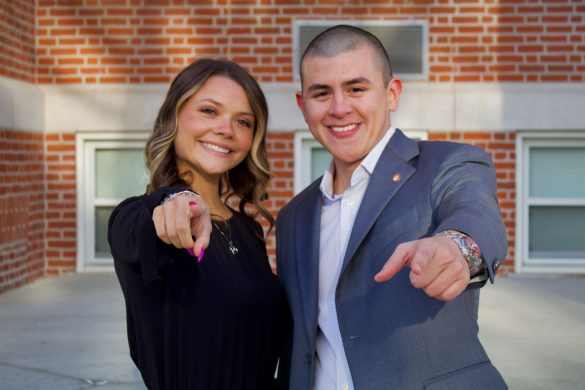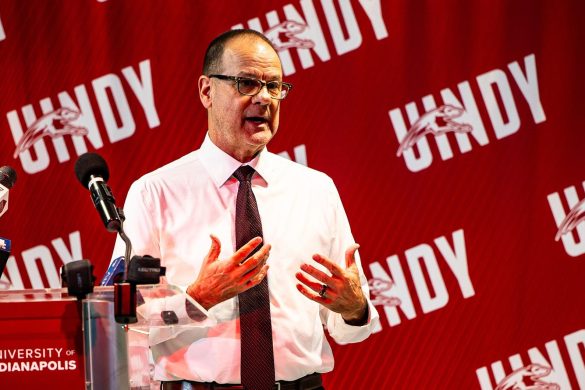The average faculty salary at the University of Indianapolis is lower than that at most comparable post-secondary institutions in Indiana.
As of the 2013-2014 academic year, statistics from the Integrated Postsecondary Education Data System show that the average salary for UIndy full professors was $78,417, for associate professors the average was $67,851, for assistant professors it was $56,754 and for instructors it was $43,488. IPEDS is an online education statistics data center that makes institutional data reported to the U.S. Department of Education available to public.
Vice President and Chief Financial Officer Michael Holstein said the university does not make individual salary data publicly available, which also is true for academia and companies beyond UIndy. He also said UIndy, like all colleges and universities, is required to report average salary data to the U.S. Department of Education.
The criteria
For this article, The Reflector considered only universities that are private and have graduate programs like UIndy’s. Although the University of Notre Dame meets these criteria, Notre Dame was not included because of the size of the school and because it is a research-focused campus. Both Holstein and Professor of Philosophy and Religion Gregory Clapper, who has been compiling data on faculty salaries since 2004, recommended comparing UIndy only to schools that are similar, to get a fair look at the salary data.
Clapper said Butler University, University of Evansville and Valparaiso University are probably the most comparable Indiana schools to UIndy because they are church affiliated and offer similar levels of programming.
“It [what faculty should make] depends on the school you are trying to be,” Clapper said. “So like Franklin [College], they do not have a graduate school in PT and OT, they are not trying to be that kind of school. Sometimes our administrators will say, ‘Well, look, you are getting better pay than Franklin.’ But they are not trying to be what UIndy is.”
Schools nearby
Within the metro area, UIndy faculty makes less than faculty at Butler University faculty, but more than Marian University. UIndy is more similar to Butler in that both schools have an extensive list of master’s degree programs and several doctoral degrees programs. Butler has more than 65 undergraduate majors compared to UIndy’s 82, according to each university website.
Butler has more than 100 more faculty than UIndy, with 348 to 241, according to IPEDS.
However, UIndy faculty make less than Butler across the board. Full professors at UIndy, on average, make $11,358 less than their counterparts at Butler; the difference between the salaries for both associate and assistant professors is, on average, almost $8,700. The gap between instructors at the schools is slightly lower, with a $6,149 average separation.
Marian University is the lowest paid university in The Reflector’s study. Marian has two master’s degree programs, one doctoral program and 36 majors, according to Marian’s website.
According to Clapper’s explanation, Marian faculty appear to make less than UIndy faculty in part because the school has fewer program offerings.
Full Marian professors make over $19,000 less than their UIndy counterparts, according to IPEDS. The average difference between UIndy and Marian associate professors is nearly $10,000. The average spread for assistant professors is a little more than $6,700. And the average gap between instructors at the schools is much smaller at $1,152.
Hoosier schools less related
Outside the metro area, but inside the Hoosier state, salaries are mixed compared to UIndy. Anderson, Taylor and Manchester universities have lower salaries across the board than UIndy. All three universities have some but few graduate programs, and all but Taylor offer fewer majors than UIndy. Taylor University offers 115 majors, but only has 129 faculty members, according to Taylor’s website and the IPEDS data.
Trine University salaries are higher than UIndy in all categories of faculty, and the full professor salary is the highest. However, Butler beats Trine in all categories except for full professor. The difference is especially pronounced when contrasting salaries for full-time professors at Trine versus UIndy. Full professors at Trine make, on average, $20,592 more annually than their UIndy counterparts.
Trine is unique because the school does not have tenure; all 85 Trine professors and instructors have yearly contracts. UIndy and all other schools in The Reflector’s study have a majority of tenured and tenure-track professors. As of 2013, UIndy had 100 tenured professors, 72 tenure track professors and 69 faculty working on an annual contract, according to IPEDS. Holstein said the IPEDS data do not account for UIndy adjuncts because there is no meaningful average of salary data to report. He said this is because adjunct pay at UIndy depends on teaching hours.
Schools like UIndy
Valparaiso faculty who are full professors earn more than UIndy faculty at the same level, but associate and assistant professors as well as instructors at UIndy make more than their Valpo counterparts. Valpo pays its full professors almost as highly as Trine, with Valpo’s average coming in at $93,330.
Valpo offers 70 majors to UIndy’s 82 and three doctoral programs to UIndy’s five, but Valpo offers 40 master’s programs to UIndy’s 28, according to the UIndy and Valpo websites.
Like UIndy, Evansville is Methodist affiliated. But Evansville only has one doctoral program, four master’s degrees programs and two fewer undergraduate majors than UIndy at 80, according to the UIndy and Evansville websites.
Evansville is lower in one of the four faculty categories, which is instructor. UIndy instructors make nearly $3,400 more than Evansville instructors. The average salary gap for Evansville versus UIndy associate professors barely exists at $72 more for Evansville.
Evansville assistant professors make $1,602 more than the UIndy average. However, the gap is larger at the top, with Evansville full professors $8,865 more than the average for UIndy full professors.
The difference between the average salaries of the various faculty classifications is much less pronounced at some schools such as Marian than at UIndy. Marian has just over $1,233 of difference between its associate professors’ and full professors’, compared to UIndy’s difference of $10,566. The difference between the average salaries of Marian’s associate and assistant professor is nearly $7,900, compared to UIndy’s difference of $13,266.
The UIndy impact
Clapper said that there used to be not much incentive for professors at UIndy to move up in classification to full professor because there was only a small pay increase. He said assistant professors are given a six-year window to prove themselves, after which time they can apply to be an associate professor.
However, he said some assistant professors can have an accelerated track to associate professor if they came in with experience from another school. To become a full professor, faculty have to teach for 12 years and have research and publications under their belt, Clapper said.
In 2013, President Robert Manuel increased the automatic raise for promotion from associate to full professor from $3,000 to $7,500. Clapper said that pay increase should provide more incentive for faculty to move up.
Even more than by faculty classification, UIndy professors also are paid differently based on what subject they teach. Holstein said that faculty in fields such as medicine, science and technology are paid more because of supply and demand.
“This is really supply and demand when it comes to how many teachers are available in a specific academic specialty,” Holstein said. “There are some [disciplines] where the supply is larger than the demand, and you would expect the price to decrease in that [discipline].”
In addition to raises for promotion, Holstein said that UIndy offers annual merit raises to faculty who meet the administration’s criteria.
Clapper said that these raises are determined based upon teaching and course evaluations, service on committees and to students as well as research and scholarship. He said most of the raise is determined by the teaching category because UIndy is a teaching-focused school.
Clapper has been compiling data on faculty salaries since 2004. He started doing this after the full faculty passed a resolution stating that the university should provide compensation that is at least average among peer schools in “no fewer than three years.” He said that it is clear the administration has not met this goal.
“Sometimes it is easier to go for the flashier things,” Clapper said. “‘Oh, we have the big new building down here. Let’s attract lots of attention and draw money to that.’ Well that’s good, and we need that. It might not be as exciting, but we [also] need to keep pace with our salaries.”










